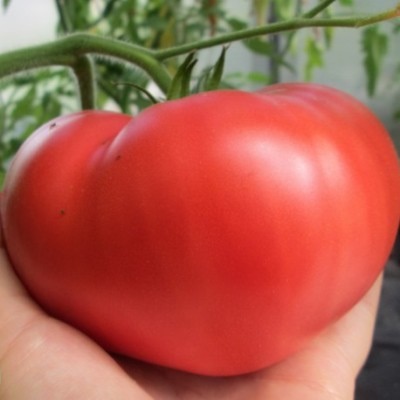
- Authors: Siberian selection
- Category: grade
- Appointment: universal
- Ripening period: mid-season
- Ripening time, days: 100-115
- Growing conditions: for open ground, for closed ground, for greenhouses
- Bush size: tall
- Bush height, cm: 200 and more
- Bush characteristic: robust, semi-compact
- Foliage: strong
Adapting originally tropical tomatoes to harsh climates is a challenge. However, they successfully learned how to solve it. One of these options is the Heart of Minusinsk tomato.
Description of the variety
By its purpose, this plant is universal. It can be cultivated both in ordinary vegetable gardens and in greenhouses under the protection of film or glass. The culture is recommended for all major regions of Russia, where only tomatoes can be grown. Its bushes reach a height of 2 m or more. Strong stems are characterized by pronounced foliage.
The main qualities of the fruit
Raspberry ripe berries are large. They can weigh up to 0.8 kg. Such tomatoes are somewhat similar in shape to a stereotypical heart, but are more graceful and have a characteristic "nose". The first inflorescence is laid above 5-6 leaves. The next ones will be formed with a step of 1-2 sheets.
Taste characteristics
The pulp of Minusinsk Heart is dense and juicy. It has a granular structure. At the same time, the seeds practically do not appear. In general, these fruits taste sweet.
Ripening and fruiting
This variety belongs to the mid-season category. Its shoots usually appear 100-115 days after the emergence of young growth. Fruiting will take a very long time. You can harvest in the last two-thirds of the summer. This process ends in September.
Yield
The Serdtse Minusinsk variety is capable of producing quite a lot of berries. The largest yields reach 10-12 kg per 1 sq. m. At the same time, one cannot ignore the fact that such a result is achieved only under the condition of good weather and competent agricultural technology. The fruits are well transported. Their safety is guaranteed in dark rooms with good ventilation for up to 20 days.
The timing of planting seedlings and planting in the ground
Sowing seeds for seedlings is optimal in March-April. Seedlings are usually ready for transfer to open ground in May or June. As always, it is necessary to be guided by the conditions and the actual maturity of the tomatoes.

Growing tomato seedlings is an extremely important process, because it largely depends on whether the gardener will be able to harvest at all. All aspects must be taken into account, from seedbed preparation to planting in the ground.
Landing scheme
Planting is carried out only according to the seedling technique. In areas of a temperate climate and in the north, premises under plastic wrap are welcome. For 1 sq. m should have no more than 3 bushes. The row spacing is at least 70 cm. The distances between the holes of Minusinsk tomatoes themselves must be determined independently.

Growing and care
The heart of Minusinsk responds responsively to irrigation.And it also accepts well the introduction of nutrients. Due to its high growth, 1-stem cultivation is recommended. After holding the seedlings under a film, it is advisable to harden it. Further, the seedlings are kept at a temperature of 18-22 degrees.
A pick on individual containers is made when forming 2 real sheets. The thickening of the planting should be immediately eliminated. Bushes planted in open ground should be watered as the earth dries up. Top dressing is applied regularly, with the same frequency as for other tomatoes. Loosening the ground (and weeding weeds at the same time) should be 2-3 times a month.
However, in some cases, these manipulations will have to be done more often. The stepsons are removed systematically, focusing on the dynamics of their growth. The first pinching is carried out immediately after disembarkation. To do this, remove the lower leaves. For the purpose of the garter, tapestries must be used.
It is worth remembering that a good potting mix for this variety is a combination of:
black soil;
washed river sand;
humus (all of this is taken in the same amount).
In general, there is not too much information about the agricultural technology of this variety. But it is worth emphasizing that approaches typical for other mid-season tomatoes are applicable to it, which partly compensates for the lack of special information. The heart of Minusinsk, like other tomatoes, should be protected from cold rains. Such an impact can destroy even the strongest and most developed bushes. It is necessary to water the plants strictly at the root.
Irrigation is carried out normally, systematically and rhythmically. It is necessary to avoid both drying out of the earth and stagnation of moisture. The water should be warm or at least room temperature. If extreme heat comes, mulching often helps. In cold conditions, it is able to save the culture from excessive cooling.




A plant needs different micronutrients at each stage of growth. All fertilizers can be divided into two groups: mineral and organic. Folk remedies are often used: iodine, yeast, bird droppings, eggshells.
It is important to observe the rate and period of feeding. This also applies to folk remedies and organic fertilizers.
Disease and pest resistance
Protection against late blight is provided not by the plants' own immune forces, but only under the condition of special preventive treatments. The same can be said about resistance to Alternaria. The easiest way to prevent these two dangerous infections is with the help of Ordan.



























































































